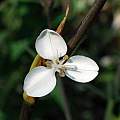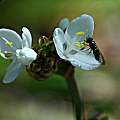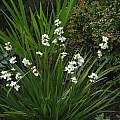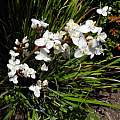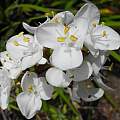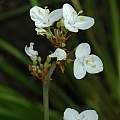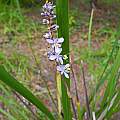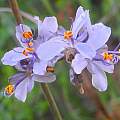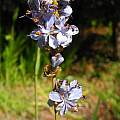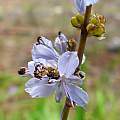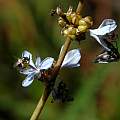Libertia is an evergreen rhizomatous genus in the Iridaceae family of about 12 species found in Australia, New Guinea, New Zealand, Chile, and the Andes from Bolivia through Colombia. It was named after Anne-Marie Libert, a Belgian botanist. The genus is well represented only in New Zealand and Chile. Plants have simple, linear or narrowly lanceolate basal leaves with a prominent central vein and except for one species short lived white flowers that are radially symmetric and held upright. This genus is distinguished by filaments united in the lower half or third and a short style with slender branches extended between the filaments. Outer tepals are slightly to much smaller than the inner. This genus is in the Sisyrinchieae tribe. It is most closely allied to Orthrosanthus.
Libertia chilensis (Molina) Gunckel, syn Libertia formosa Graham, is a species from Chile with fan like bluish-green leaves and white flowers with spreading segments. The inner segments are obovate and the outer small, oblong, greenish brown. According to Chileflora this species grows in water or has its roots within a permanent water source so should not be kept dry for a long period of time. Height range: to about 1 m. This may explain why it did not thrive in Mary Sue Ittner's garden, but below is a photo taken the year she planted it out (and before the summer dry period in her California garden.)
Libertia grandiflora is native to New Zealand. It has long leathery iris like leaves and umbels of white flowers on stiff stems. It is surviving in my garden with little summer water, but probably would be happy with more. It blooms in spring. Height range: to about 1 m. Photos by Mary Sue Ittner.
Libertia sessiliflora (Poepp.) Skottsb., syn. Libertia caerulescens Kunth & Bouché, is native to Chile where it grows in coastal areas from 0 to 500 m. It has green, upright, linear leaves. It is the only species that does not have white flowers, instead having small pale blue flowers. Another difference is the flowers face to the side instead of upright and are borne on short pedicels. This species has an oblong capsule. The other South American species have globose capsules and long pedicels with flowers held well above the stem. Height range: 30-60 cm. Photos from Bob Rutemoeller and Mary Sue Ittner show the plant and flowers in various stages, a pollinator, and finally the fruit.
